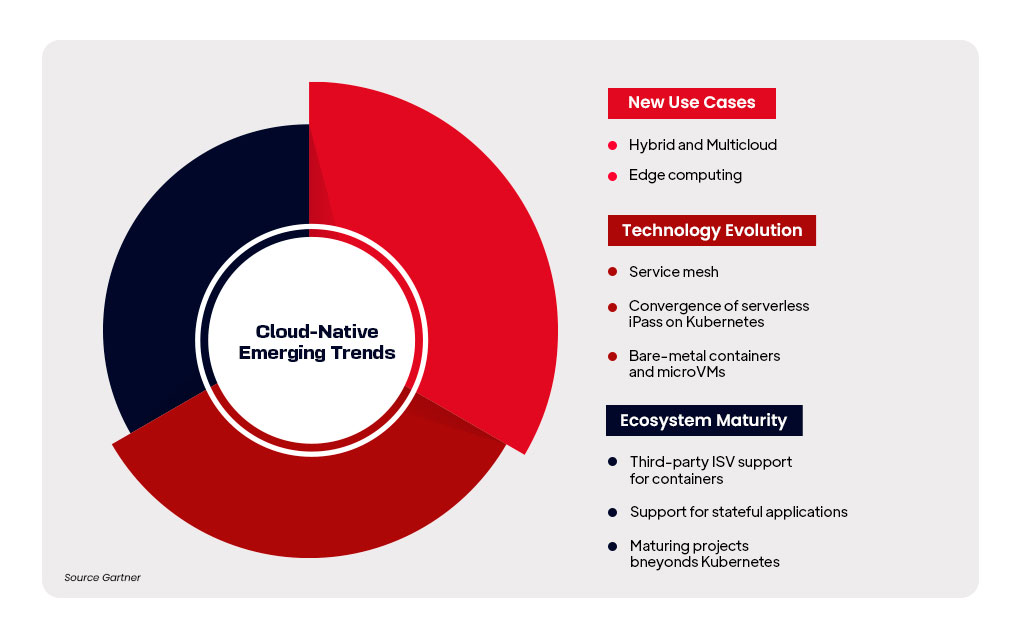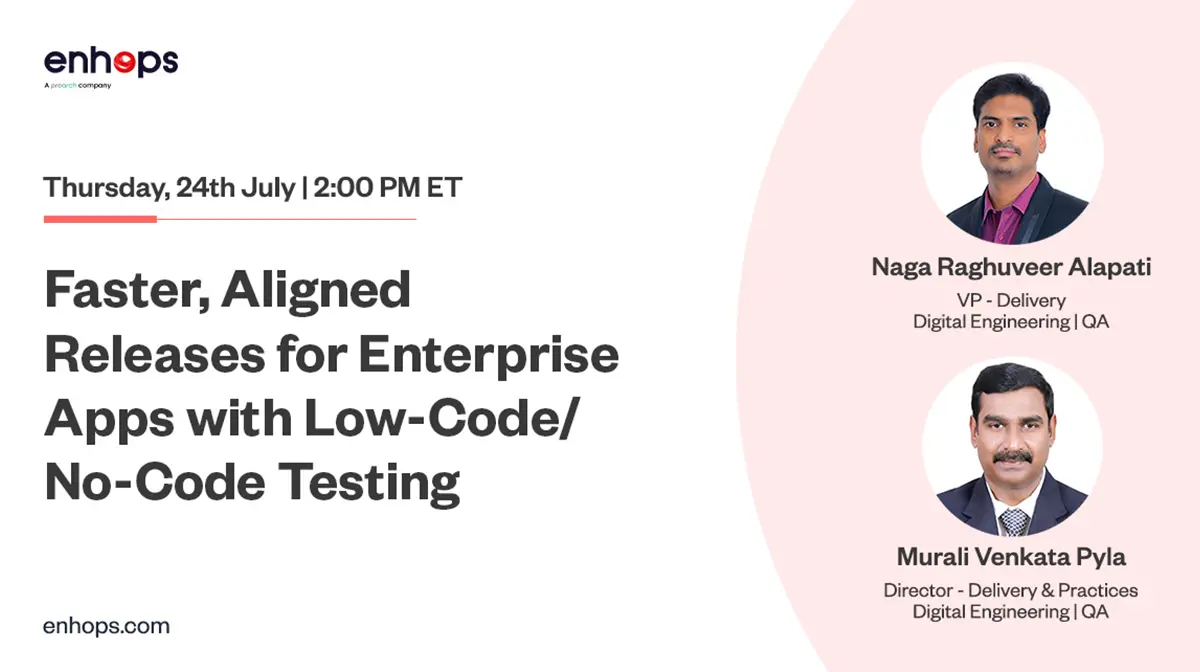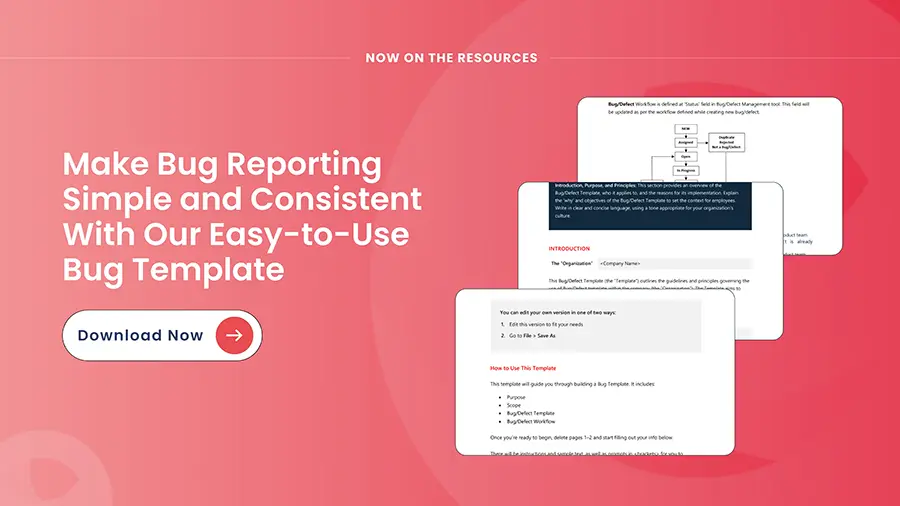Gartner predicts that by 2025, more than 95% of new digital workloads will be deployed on cloud-native platforms, up from 30% in 2021. One more similar research by Tigera points out that 75% of companies are focusing on building cloud-native applications.
These numbers make sense as businesses want more agile, scalable, and flexible business applications to fulfill rising customer expectations. Every minute the digital transformation plans are evolving and with traditional infrastructure, it is impossible to cater to these evolving plans.
Against this backdrop, there’s no arguing the fact that cloud-native engineering is a now a necessity for businesses to stay competitive. Hence, it is important for CIOs and technology leaders to understand the principles, benefits and implementation of cloud-native engineering to make the best out of their digital transformation plans –
A quick refresher –
The term Cloud Native Engineering refers to the concept of building, testing, and deploying applications that run in cloud to take advantage of cloud characteristics like scalability, elasticity, resiliency, availability, and flexibility.
As Cloud Native Computing Foundation (CNFC) defines, Cloud native technologies empower organizations to build and run scalable applications in public, private, and hybrid clouds. Features such as containers, service meshes, microservices, immutable infrastructure, and declarative application programming interfaces (APIs) best illustrate this approach.
Benefits of Cloud Native Engineering
Digital economy needs organizations to develop, deliver, and refine software applications at a faster speed. Frequent updates require infrastructure scaling up and down for keeping a tab on costs.
Additionally, organizations need to be always prepared for replacing failed components, integrations across the application stacks, and embracing new-age technologies like IoT, Automation, Self-Service Infrastructure, Blockchain, and Composable applications. Traditional infrastructure fails at providing the required flexibility, scalability, and seamless integration possibilities.
Organizations adopt cloud native applications and engineering based on their organizational goals. Some benefits that cloud native engineering brings to the table are:
- Reduces Value to Market – Cloud Native Engineering employs the concept of running applications on the cloud without the need of managing the underlying infrastructure. With the elimination of infrastructure management and quick provisioning of infrastructure, it becomes easy for developers to develop and deploy applications.
Further, the PaaS services provided by leading cloud service providers are technology and tool agnostic making it easier for developers to shift their service providers without fear of vendor lock-ins. Cloud also provides chances of automation and developing Minimum Viable Products or MVPs and topping them off with customer loved features while running the application as-is in the background.
- Enhances Customer Experience – Customer Experience depends on how smoothly customers can interact with applications and ensures that their end-needs are met without any hinderance. Cloud Native Engineering helps organizations in releasing software in small and meaningful ways without experiencing any downtime, hence being always available for customers. This enhances customer experience directly.
- Improves Developer Productivity – Cloud Native Engineering is CI-CD friendly; this means developers can automate unwanted tasks from their routine development operations. CI-CD promotes one-click deployments, standardized cloud environments without any dependency on the infrastructure teams and move faster without breaking things.
Cloud Native Engineering principles like infrastructure as code, serverless architecture, orchestration platforms and real-time analytics make the whole coding and development experience smooth. The ability to achieve more things in an efficient and automated way with straightforward infrastructure management fuels productivity multiple times.
- Promotes Innovation at Scale – Cloud Native Engineering provides freedom to scale (provision infrastructure on demand), outsource manual tasks to automation (upgrading and maintaining infrastructure lifecycle), and enables wide adoption of agile development practices. Additionally, it provides the capacity to roll out things faster but also roll back them even things go south. All of these make a perfect recipe for innovation.
Cloud Native Engineering provides flexibility to build small prototypes or conduct viable Proof of Concepts across organization. This gives team chance to showcase working prototypes and earn buy-in from management to overcome organizational inertia and fear of change.
- Cost Optimization across organization – Cloud Native Engineering allows real-time monitoring of cloud resources that helps in identifying the idle resources and also right-sizing the servers, scaling up and down based on requirements, and reassess cost by estimating team and project requirements.
The cloud cost management and spending tools make it easy for operations team to track the resources and establish rules for resource provisioning. With secured and authorized access, it is possible to control the cloud spend and manage it to bring cost optimization across organization.
- Eases Infrastructure Management – Cloud Native Engineering simplifies the infrastructure management as the major chunk of responsibilities fall on the cloud service providers. They have taken over tasks related to operating systems, hosting servers, upgradation and maintenance, networking and security, freeing up developers from all collaboration related tasks with IT. Developers now just push the code and infrastructure teams manage more important tasks like supply chains, operations, and strategic partnerships.
Technologies like Kubernetes, Docker, Serverless functions, APIs, Kafka, and PaaS makes it easy to manage multiple instances. Industry leading cloud platforms provide one-stop solution for development and deployment requirements so that organizations can build applications faster.
- Automation and Flexibility – Cloud Native Engineering allows building and running of applications in modern and dynamic environments like public cloud, private clouds, and hybrid clouds. It makes them easy to scale, access, and allow ultimate flexibility to decouple applications and their deployment operations from chaotic infrastructure layers. Cloud native engineering uses CI-CD and DevOps approach which emphasizes on automating manual and repetitive tasks and infrastructure operations.
- Portability – Cloud native engineering can provide extreme portability for applications when done with technology and tool agnostic vendors. The Cloud Native Computing Foundation promotes the adoption of vendor-agnostic, open-source, cloud-native computing technologies. It’s important to select tool stacks that can run across public, private, hybrid and on-prem clouds.
Looking for Cloud Native Application Development?
Talk to our experts to convert your ideas into high-quality digital applications with our Software Product Engineering services?
Few Real-time use case of Cloud- native engineering
Scenario 1
An online video streaming service Mux transformed the way it does business with the help of a cloud-native solution. Mux’s workflows contain a number of moving parts. For orchestration, the company relied on the Rancher stack and Docker containers at the outset. Despite this, it experienced problems with network stability. To boost productivity in version management and deployment, it shifted to Kubernetes.
Scenario 2
As part of its digital transition journey, Smart Cards selected a reliable cloud solution. In order to assist the client with automated software delivery and speed up time to market, Infopulse developed a custom cloud solution using DevOps best practices, extensive knowledge of Docker containers, and Kubernetes. 80,000 Euros were saved by a French software and hi-tech production company as a result of the project.
Scenario 3
It was imperative for InfluxData to implement a multi-cloud and multi-regional strategy in order to accelerate the delivery of its products and services. Developing an application that could accommodate the specific characteristics of each cloud provider was the challenge. The company chose Kubernetes as a result of its quest to build a true cloud abstraction layer that would enable frictionless delivery of its database across all three major cloud providers: Amazon Web Services, Google Cloud, and Microsoft Azure.

Cloud Native Engineering Principles
While adopting the cloud native engineering, it is important for any organization to build applications around these seven principles.
- Scalability – Organizations and their user demands keep growing. It is a thing of past to get stuck with single vendor and not able to support new users or add more functions in existing application. The cloud native engineering takes care of these things by using dynamic and modern architecture using new age development technologies like containers, APIs, and microservices.
- Resilient – In a book Cloud Native Go, Matthew Titmus, a veteran of Software Product Development community explains the term Resilient very beautifully –
Resilience (roughly synonymous with fault tolerance) is a measure of how well a system withstands and recovers from errors and faults. A system can be considered resilient if it can continue operating correctly—possibly at a reduced level—rather than failing completely when some part of the system fails.
The cloud native engineering must consider the data flow and load that is ingested into the system. For applications to be fault-tolerant and run as expected, it is important to understand the real-time data flow into the production environment. The principle of scalability also comes into action here – for example, your application to be fault-tolerant and process trillions of data per seconds, your architecture must be auto-scalable.
Auto scalability gives the power to go up and down based on the resources’ consumption and future demand. These days there are AI and ML powered cloud auto-scalers that can predict the demand and helps in preparing for any application or system failure by restoring the last stable copy of the application.
- Monitorable and Manageable – As we say, “What gets measured, gets improved”. The same principle applies to cloud native engineering too. The bottom-line is to collect data, understand its value, measure the right things, and take informed decisions while improving the numbers that matter for businesses.
Cloud native engineering principles rely heavily on DevOps, Agile, APIs, Cloud Monitoring, and Big Data. All these principles/methodologies or technologies enable engineering teams to focus more on numbers and start taking appropriate actions to improve numbers.
DevOps focuses on tight collaboration between development, operations, security, and testing so that a team can increase their release velocity while taking care of the quality. Same goes for agile practices.
APIs and Cloud Monitoring tools help organizations in understanding their cloud consumption and optimize it based on needs and resources. In traditional data center model, it is so common to keep paying for the infrastructure that has been used once or twice in a year. On top of it, managing infrastructure in-house is messy owing to niche skills they need, and the processes teams need to follow.
- Automation – Automation is like a holy grail for cloud computing and infuses life into all other principles. Scalability depends on automation to expand and condense computing resources on demand, similarly resilience comes with automation of performance, stress, and load testing. That makes applications capable of handling stress with increase in traffic, data volume, and other parameters.
Automated monitoring tools allow teams to keep a track of what is running and what is not. They also indicate any deviations in the systems or applications which allow teams to act before the systems fails or experience any downtime.
Automation also smoothens the delivery process by automating the build processes, testing, and infrastructure provisioning. Rather than manually releasing versions and experiencing human errors, cloud deployment tools like AWS’ Code Pipelines, Google’s Cloud Build, or Azure’s Pipelines ensures consistency in releasing software.
While there’s a lot automation takes care of, human counterparts are always needed to make sure that automation processes are configured properly and should be modified from time to time to suit the most recent needs of business.
Enhops’ Cloud Native Engineering Services
Cloud-native engineering brings a lot of benefits that complement the digital transformation plans for any organization. While the benefits make it highly lucrative to invest in efforts and time, it can be time-consuming and failure prone in first few attempts, if done without proper technical and change management expertise.
Enhops, a ProArch company has helped multiple clients by building cloud native applications and helping them embrace cloud native technologies. Our range of expertise in building solutions varies from Payment Tokenization to Utility Applications to Customer Portal Applications. Reach out to us if you want to achieve business agility and speed with cloud-native engineering and applications.
We love to offer free POC for business changing ideas.




